The Palais Des Congres, Lyon, France |
Read more at in70mm.com The 70mm Newsletter |
| Written by: Jean Noel Durand Bourat | Date: 03.03.2018 |
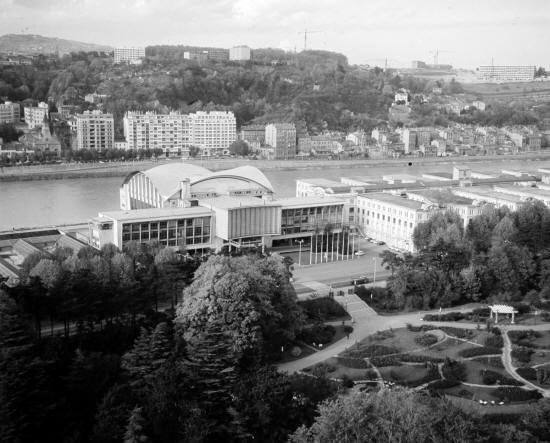 1961 to 1963: The versatile multi purpose
venue 1961 to 1963: The versatile multi purpose
venueThe Palais Des Congres was built in 1961 in the brutalist style. It was the work of architect Marcel Salagnac. The venue was not intended to be used only as a Convention Centre. The “grand auditorium” originally seating 1200 was also purpose built to accommodate live entertainment on a very large stage as well as 70 mm films shown on a 22x10 metres flyable screen that filled the full proscenium arch. The opening film was “Barabas” in Super Technirama 70 followed by “My Fair Lady” in Super Panavison 70 |
More in 70mm reading: 70mm in Lyon, France Closure of a 70mm theatre in Lyon, France 70mm Cinema and Film in France |
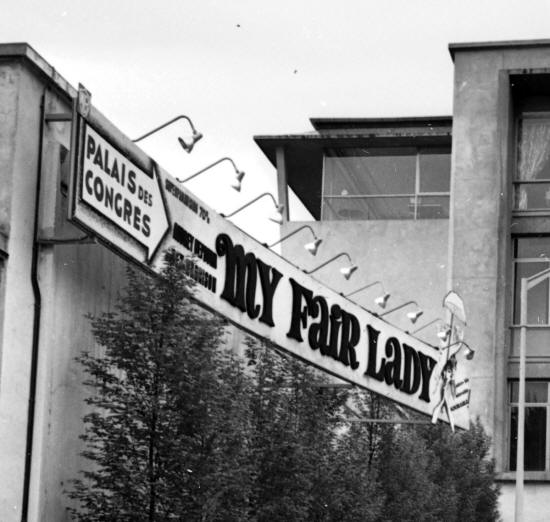 04/18/63 to 03/11/64: The 3 strip Cinerama sequence 04/18/63 to 03/11/64: The 3 strip Cinerama sequenceIn April 1963 the PALAIS was retrofitted with a new even wider gigantic curved screen to showcase 3 panel Cinerama. The new screen was not flyable as its sides protruded from the proscenium arch. This meant the stage could no longer be used. Three films were shown in the 3 panel process : “How the West Was Won”, “Cinerama Holiday”, and the “Wonderful World of the Brothers Grimm”. I recall my first visit to The Palais. As an 11 years old child I was accompanied by my mother and my father who was then the chief projectionist of the Cinéjournal. in the centre of Lyon. No wonder my dad’s counterpart was waiting for us in the lobby for a private tour of the projection suite. I already had ascended to many projection booths, but it was the first and last time I did so by means of a lift. Yet my surprise was to turn into amazement when the door opened to the projection suite displaying..... six projectors in a row! • a single Hortson 16 mm projector with arc lamphouse meant to be used during conventions. • Followed by an array of 3 of the latest Century Cinerama projectors. Both of the enormous film reels were placed at the bottom of the units for easy loading. • Then, inserted between the Cinerama projectors, a couple of Philips DP70s featuring Ashcraft Super Cinex lamp-houses powered at 150 amps. The 35mm Cinerama Sound reader occupied the far end of the room in close vicinity to the rack of six Philips 50 W vacuum tubes amplifiers |
|
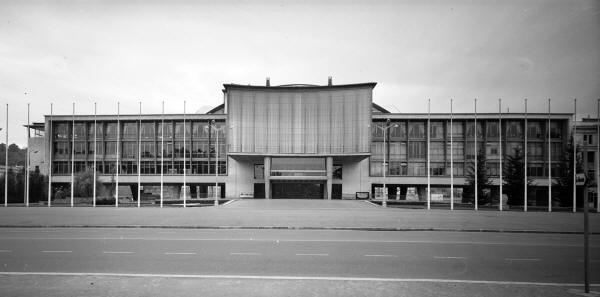 The visit of the booth ended up with the discovery of the so called “Gigolo
system” a water cooled moving film frame that blurred the edges of the
pictures so as to soften the seams between the 3 Cinerama panels.
Unfortunately the system was not perfectly effective when the seams occurred
in bright even colored zones of the panoramic picture. Yet when the black &
white 1,33 academic standard mono prologue of ”Cinerama Holiday” exploded
into the gigantic full colored stereophonic panorama of the Alps the moment
was unforgettable. The visit of the booth ended up with the discovery of the so called “Gigolo
system” a water cooled moving film frame that blurred the edges of the
pictures so as to soften the seams between the 3 Cinerama panels.
Unfortunately the system was not perfectly effective when the seams occurred
in bright even colored zones of the panoramic picture. Yet when the black &
white 1,33 academic standard mono prologue of ”Cinerama Holiday” exploded
into the gigantic full colored stereophonic panorama of the Alps the moment
was unforgettable. |
|
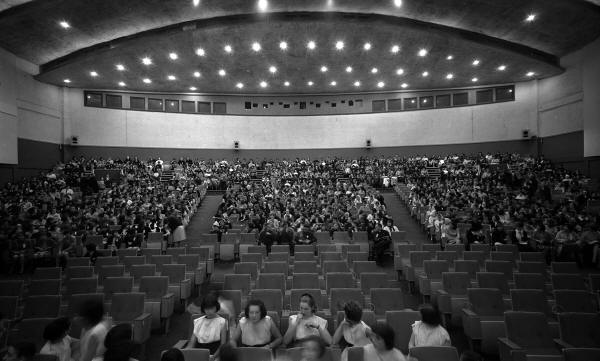 1964 to 1971: 70mm is back and is here to stay 1964 to 1971: 70mm is back and is here to stay
“And now Ladies and Gentlemen this is Seamless Cinerama” could have been used as an intro to "It's a Mad Mad World" the feature that introduced 70mm Cinerama. The 3 strip machines and the separate sound readers were removed from the Palais des Congres and a pair of Ultra Panavison anamorphic attachments were fitted to the good (not old) DP70s and thus the venue rode into legend even if “El Cid” was one of the rare 70mm production not to hit the Palais' great curve. The most outstanding Cinerama-labeled 70mm films were shown. “Ice Station Zebra”, “2OO1: A Space Odyssey”, “Kharthum”, “The Fall of the Roman Empire”. “Battle of the Bulge” was marketed through a military Parade with a detachment of real soldiers and a batch of real tanks sporting posters of the film all this to the sound of a real marching band playing selections from the film score. Some other 70mm film were shown in that periode including “The Cardinal”, ”Tora Tora Tora” and re-runs of such masterpieces as “Ben Hur” and “Lawrence of Arabia” playing to packed houses although these films already had very long and very successful first run at The Comeadia. “Gone with the Wind” in new 70mm screen splendour and stereophonic sound completed this series. The next step was the implementation of Curvoulon lenses to exhibit “The Bible...in the Beginning” and “Patton” in D-150. |
|
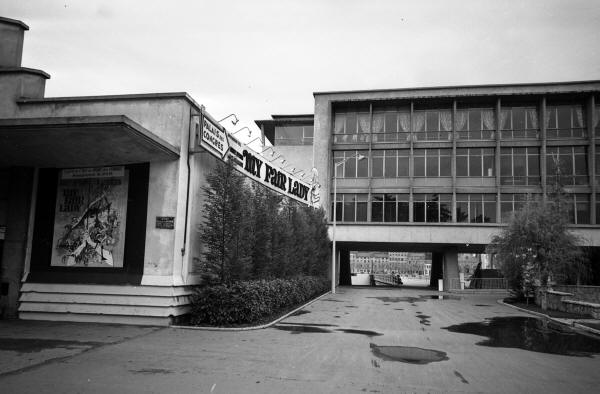 1971 to 1977: 35mm + 70mm re-runs and Sensurround 1971 to 1977: 35mm + 70mm re-runs and SensurroundSo far all the feature films presented at the Palais had been projected on the full 200 square metre 120 degree screen whatever the filming process used. Things changed in the early 70s for want of 70 mm releases in France. Mobile screen masking were fitted to reduce the height and width of the screen which in any case remained the largest in Lyon. The only 70 mm shows between 1972 and 1977 were a few re-runs including “Ben Hur”, “The fall of the Roman Empire”, “West Side Story” , “That's the Way it is” and “Eathquake” with Sensurround and stereophonic sound. Probably the technological climax of the Palais des Congrès. “The battle of Midway” , “Rollercoaster" and "Battlestar Gallactica” were also presented with Sensurround but in 35mm. |
|
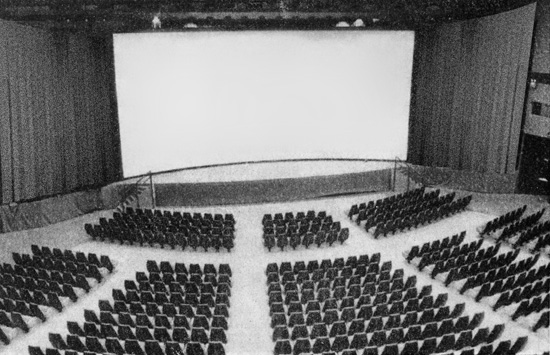 The auditorum as seen from the projection
suite a few days before demolition in 1996 The auditorum as seen from the projection
suite a few days before demolition in 19961977 to 1991: The blockbuster era When in 1977 most of the teen agers who flocked to see “Star Wars a New Hope” had only seen 35mm projected on postage stamp sized screens and optical mono sound were in for a big surprise. When after the trailers the curtain was shot no one heard the screen masking silently moving. The lights went off and the historic Fox Logo splashed on the full curtain that slowly opened and opened... and opened to reveal the full size of the old Cinerama Screen to the tunes of the Fox Fanfare in stereophonic sound …. and suddenly the roars of spaceships coming from the rear, flying above the head of the bewildered youth and bursting onto the gigantic screen. The magic of 70mm was back with the Force. 70mm showings in that period included the full original trilogies of “Star Wars” and “Indiana Jones”. “The Black Hole”, “Tron”, “The Untouchables”, “Alien”, “Top Gun”, “Greystoke”, “Carmen”, “The Right Stuff”, ”Mad Max 3 Beyond Thunderdome” and very successful re-runs of “Mackenna's Gold”. |
|
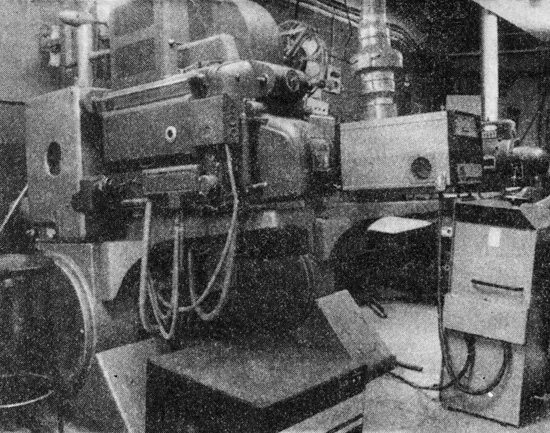 The booth after one DP 70 had been
retrofitted with platters and a 700w Xenon lamp house. The second DP 70
retaining its Ashcraft arc was then only intended as a back-up The booth after one DP 70 had been
retrofitted with platters and a 700w Xenon lamp house. The second DP 70
retaining its Ashcraft arc was then only intended as a back-upUntil the release of “Indiana Jones and the Last Crusade” 35mm showings were performed in Dolby stereo CP 50 while 70mm was still exhibited in 6 track mag. The second “Indianna Jones” opened the era of CP 200 6 track Dolby stereo. On that occasion the surround speakers were replaced by new smaller more numerous units while xenon was introduced on one of the DP70 that was fitted with 70 mm capable platters for single projector automated projection. That was to be the last evolution in the outstanding equipment of the Palais that had to close in 1991 following structural disorder in the foundations of the building. It was demolished in 1996 to give way to a brand new Convention Centre to the design of Renzo Piano. The Cité Internationale as it is called includes a state of the art 14 plex cinema. Originally the DP70s of the old Palais were to be reinstated in each of the 2 largest auditoria. Unfortunately that plan was never carried out and nowadays no film venue in Lyon is capable of showing 70mm not even in the giant screen cinema of the Lumiere Institute. How sad! |
|
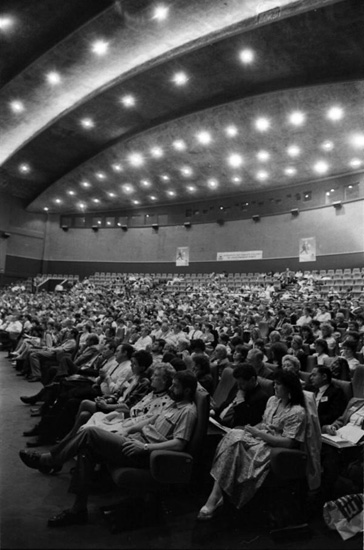 |
|
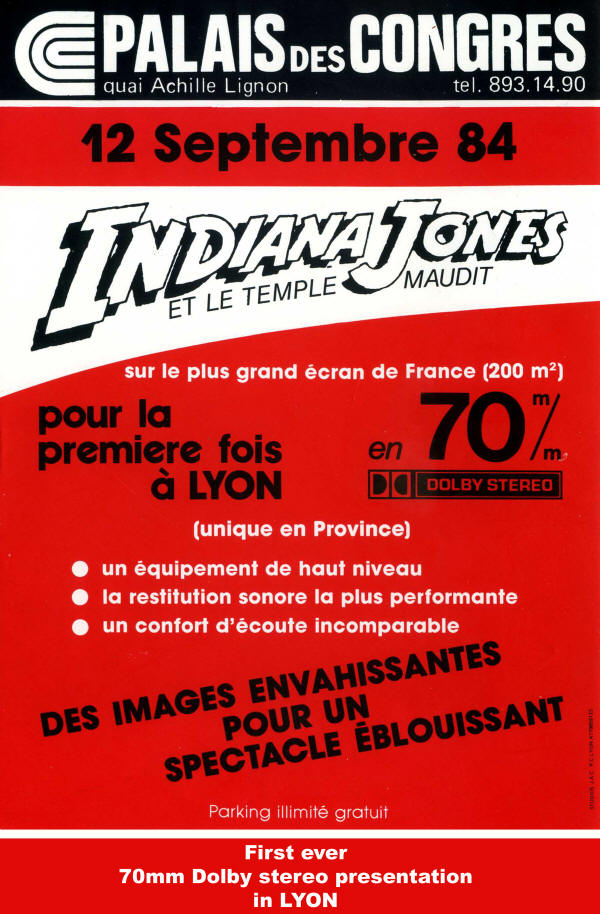 Click
on the advert to see a large version Click
on the advert to see a large version |
|
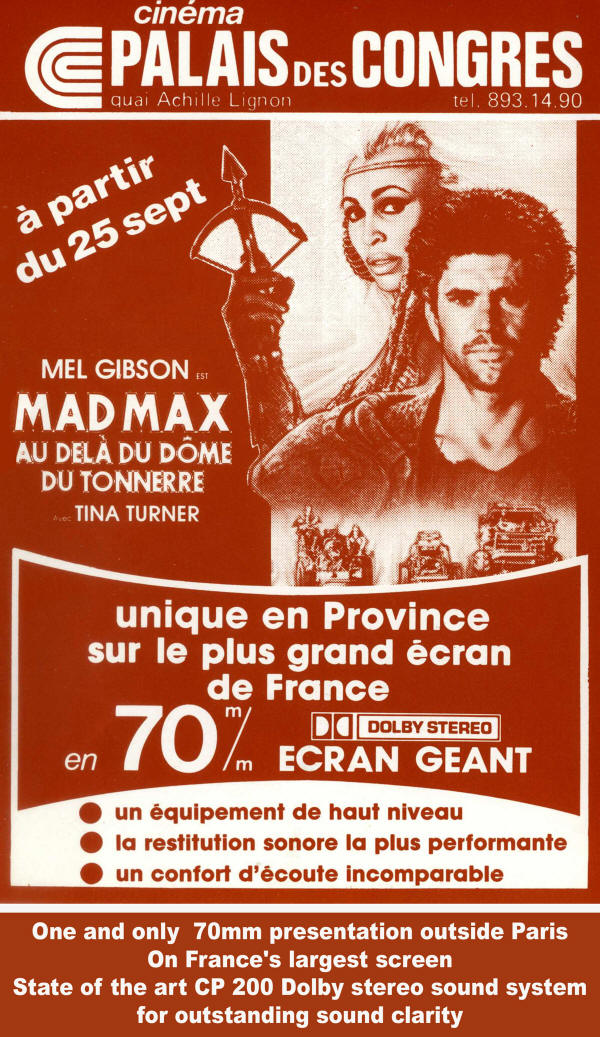 Click
on the advert to see a large version Click
on the advert to see a large version |
|
 Click
on the advert to see a large version Click
on the advert to see a large version |
|
| Go: back - top - back issues - news index Updated 21-01-24 |
